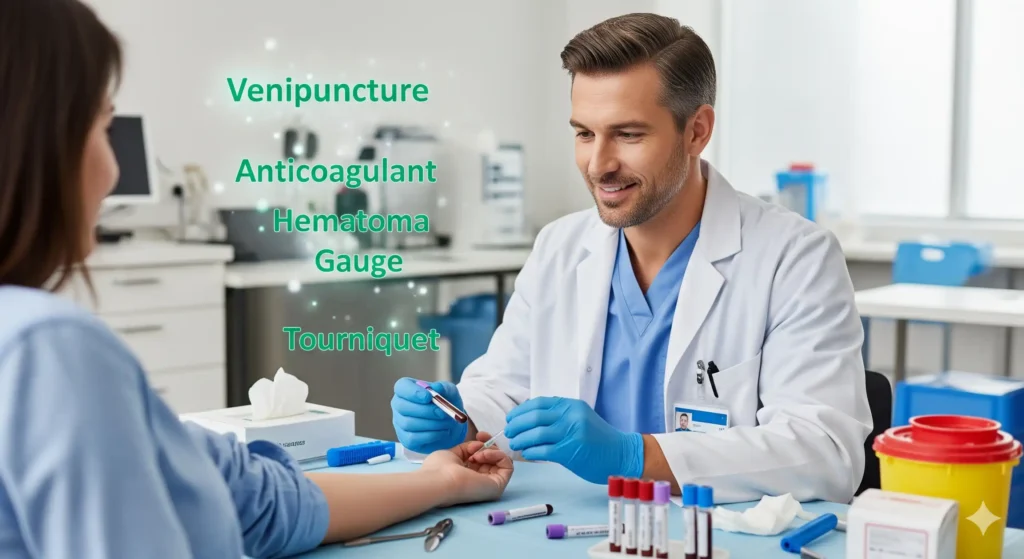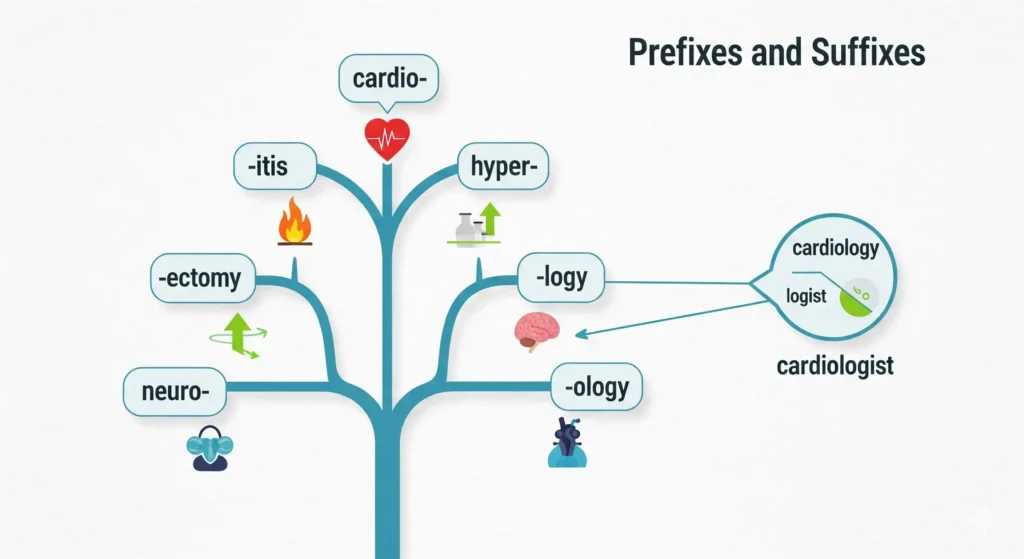If you’re beginning your journey in phlebotomy, one of the most important steps is learning to “speak the language of healthcare.” Medical terminology is the backbone of communication in hospitals, clinics, and laboratories. At first, the long and complex terms might feel intimidating, but once you break them down into prefixes, suffixes, and root words, they start to make sense.
Understanding medical terminology will not only boost your confidence but also make you more effective when interacting with patients and other healthcare professionals. A strong grasp of these terms ensures that you can follow instructions correctly, record patient data accurately, and reduce the risk of errors during blood collection.
In this blog, we’ll explore key medical terminology that every phlebotomy student should learn, with explanations, examples, and practical applications in real clinical settings.

Why Medical Terminology Matters in Phlebotomy
Phlebotomy may seem like it’s “just drawing blood,” but in reality, it’s a vital role that requires precision, communication, and patient care. Here’s why terminology is so important:
- Clear Communication: Medical terms act as a universal language. Instead of saying “the vein near the thumb,” you can confidently say “cephalic vein,” ensuring accuracy in patient records and lab requests.
- Professional Confidence: Patients feel reassured when a phlebotomist explains the procedure using professional yet understandable terms. It shows you know your craft.
- Exam Preparation: Certification exams often include terminology questions. Knowing your terms ahead of time helps you perform better.
- Efficiency in Clinical Practice: When working with doctors, nurses, or lab staff, the ability to use precise terms prevents delays and misunderstandings.
1. Basic Anatomical Terms
Phlebotomy revolves around human anatomy, especially the circulatory system. These directional and positional terms are essential because they help you identify and describe the correct blood draw sites.
- Anterior / Posterior – “Anterior” refers to the front of the body (chest, face, palms), while “posterior” refers to the back (spine, back of head). Example: The antecubital fossa (common blood draw site) is located on the anterior side of the elbow.
- Medial / Lateral – “Medial” means closer to the midline of the body, while “lateral” means further from the midline. For example, the basilic vein lies medial, and the cephalic vein lies lateral in the arm.
- Cephalic – Refers to the head or, in phlebotomy, the cephalic vein located on the lateral side of the arm.
- Distal / Proximal – “Distal” means farther from the point of attachment, while “proximal” means closer. Example: The wrist is distal to the elbow, which helps you describe vein locations accurately.
Why this matters: When you start performing venipuncture, you’ll often be asked to locate veins using these terms. Knowing them ensures you don’t mistake one vein for another, which can directly affect patient safety.
2. Blood and Circulatory System Terminology
Phlebotomy is directly linked to the circulatory system, so understanding the structures and processes involved is critical. Knowing these terms ensures you can correctly identify where and how to collect blood, while also understanding what happens inside the body.
- Vein – Veins are the blood vessels most commonly used in phlebotomy. They carry deoxygenated blood back to the heart. Common veins used for venipuncture include the median cubital vein, cephalic vein, and basilic vein in the arm.
Example: When performing a blood draw, the median cubital vein is often the first choice because it’s stable and less painful for the patient. - Artery – Arteries carry oxygen-rich blood away from the heart to the rest of the body. Unlike veins, they have thicker walls and pulse with each heartbeat. Blood is rarely drawn from arteries except in specialized tests such as arterial blood gas (ABG) analysis, which requires advanced training.
- Capillaries – Tiny, thin-walled vessels that connect arteries to veins. They allow for the exchange of oxygen, carbon dioxide, and nutrients between blood and tissues. Capillary blood is often collected through fingersticks or heelsticks, especially in newborns and when only small amounts of blood are needed.
- Venipuncture – The standard procedure of puncturing a vein with a needle to collect blood. It’s the primary skill in phlebotomy, and learning correct venipuncture techniques reduces patient discomfort and prevents complications such as hematomas.
- Hemostasis – The body’s natural process of stopping bleeding. It involves vasoconstriction, platelet plug formation, and blood clotting. Understanding hemostasis is important for recognizing patients with clotting disorders and for knowing how long to apply pressure after removing the needle.
Why this matters: Without knowledge of these terms, a phlebotomist risks using incorrect techniques, which can lead to complications like nerve damage, hematomas, or incorrect sample collection.
3. Laboratory & Testing Terms
Once blood is collected, it goes through various laboratory processes. A phlebotomist’s role doesn’t end with venipuncture — you must also understand the types of samples you’re handling and why specific tests are ordered.
- Serum – The liquid portion of blood that remains after clotting has taken place. Serum is commonly used in chemistry tests (such as liver function tests, cholesterol levels, and hormone studies). It is obtained by allowing blood to clot and then centrifuging the sample.
- Plasma – The liquid part of blood that still contains clotting factors. Plasma is separated by collecting blood in a tube with anticoagulants (like EDTA or citrate). Plasma samples are essential for coagulation tests, electrolyte levels, and blood typing.
- CBC (Complete Blood Count) – One of the most common tests ordered in healthcare. It measures red blood cells, white blood cells, hemoglobin, hematocrit, and platelets. Phlebotomists frequently collect blood for CBCs, as it helps diagnose conditions like anemia, infection, and clotting disorders.
- Glucose Test – Measures the amount of sugar (glucose) in the blood. It’s critical for diagnosing and monitoring diabetes. Patients may be asked to fast before a fasting blood glucose test, or undergo a glucose tolerance test (GTT), which requires multiple timed blood draws.
- Coagulation Test – Evaluates how quickly blood clots. Common examples include PT (Prothrombin Time), aPTT (Activated Partial Thromboplastin Time), and INR (International Normalized Ratio). These tests are especially important for patients on blood-thinning medications like warfarin.
Why this matters: As a phlebotomy student, you won’t just collect blood; you’ll also need to handle samples correctly depending on the test ordered. For example, using the wrong tube (serum vs. plasma) can make the sample unusable, delaying diagnosis and patient care.

4. Common Medical Prefixes and Suffixes
One of the easiest ways to understand medical terminology is by breaking down words into prefixes, root words, and suffixes. Recognizing these parts allows phlebotomy students to interpret complex terms without memorizing each word individually.
Hemo- / Hemato- – Refers to blood.
Example: Hematology is the study of blood and its disorders, while hemoglobin is the protein in red blood cells that carries oxygen.
-itis – Indicates inflammation.
Example: Phlebitis is inflammation of a vein, which is important to recognize for patient care during blood draws.
-emia – Refers to a blood condition.
Example: Anemia is a condition where the blood has a lower than normal number of red blood cells or hemoglobin.
Veno- / Phlebo- – Related to veins.
Example: Venipuncture is the process of accessing a vein for blood collection, a term every phlebotomy student must master.
-logy – Means the study of a subject.
Example: Hematology, the study of blood, is a foundational topic that phlebotomists often encounter in labs.
Tip: Many phlebotomy terms are combinations of these prefixes and suffixes. For instance, “phlebotomy” itself comes from phlebo- (vein) and -tomy (cutting), meaning “vein incision.” Breaking words down like this makes learning medical terminology easier.
5. Patient Interaction & Safety Terms
Phlebotomy isn’t just about technical skill — patient care and safety are just as important. Knowing the right terminology helps you communicate effectively and keep procedures safe.
- Consent – Before any blood draw, a patient must give permission. Always explain the procedure in simple terms and ensure the patient understands.
- Aseptic Technique – Using proper hygiene and sterilization to prevent contamination. This includes hand washing, disinfecting sites, and handling needles safely.
- Allergy – Always ask if the patient has allergies, especially to adhesives, antiseptics, or latex gloves, to prevent reactions during blood collection.
- Fainting (Syncope) – Some patients may feel lightheaded or faint during a blood draw. Knowing the term helps you recognize symptoms and take immediate action to ensure safety.
- Infection Control – Standard precautions like using gloves, masks, and properly disposing of needles protect both the patient and the phlebotomist.
Practical Tip from Fitness Tips Expert: Just as personal trainers emphasize proper form to prevent injury, phlebotomists must follow protocols precisely to avoid complications and keep patients safe.
6. Equipment & Procedure Terminology
Knowing your tools is just as crucial as knowing anatomy. Phlebotomists need to be familiar with both common and specialized equipment.
- Tourniquet – A strap used to temporarily restrict blood flow, making veins easier to locate.
- Needle Gauge – Refers to the diameter of the needle. Smaller numbers mean larger needles. Selecting the right gauge reduces patient discomfort and ensures proper blood flow.
- Vacutainer – A vacuum-sealed tube system for collecting blood efficiently and safely.
- Lancet – A small needle used for fingersticks or heelsticks, commonly in glucose testing or pediatric patients.
- PPE (Personal Protective Equipment) – Includes gloves, masks, gowns, and sometimes face shields. PPE is essential for protecting both the phlebotomist and the patient from infections.
Pro Tip: Just like a fitness expert needs to know their equipment to train clients safely, a phlebotomist must master their tools to perform procedures confidently and efficiently.
Final Thoughts
Mastering medical terminology is like learning a new language — it takes time, repetition, and practice. But once you have a solid understanding, it will enhance your confidence, improve patient care, and strengthen your professional skills.
Practical Tip: Keep a small notebook or use flashcards for terms you encounter during your training. Repetition and real-world application will help you retain knowledge much faster.
By practicing these terms regularly, phlebotomy students can build a strong foundation for success in both their studies and professional careers.


